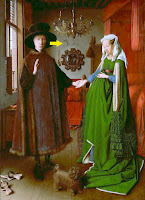A fish-eye view of the world
I recently took a photo of a
set of grass trees we have in our backyard. It was one of my “test shots” solely
for exploring some features of the DSLR, including the quaintly named toy
camera effect. The end result was that the object I was focussing mainly on
(namely, the grass trees) came out magnified while the surrounding scenery got
a bit attenuated. It is rather similar to what appears in
the mirror in van Eyck’s brilliant painting from 1434,The Arnolfini Portrait.
(Of course, any such
resemblance to such great art was wholly unintended.) Some call this effect of
deliberate distortion a fish-eye view. (By the way, how did scientists work out
how the world looks to a fish? Wouldn’t their conclusions be subject also to
the lacunae in perception that American philosopher Thomas Nagel discussed in
his famous essay on the mind-body problem, What is it like to be a bat?)
 |
| Jan van Eyck, The Arnolfini Portrait, 1434. |
It is clear therefore that
I can use technology to transform a picture into one that could be quite
different from what I saw with my own eyes. For instance, I could use “panorama
stitching” and combine a number of images to show a field of view considerably
wider than that of the human eye. It would appear that there is some lack of
truth-telling when it comes to our photographs. My disdain for photo-shopping at
the outset was perhaps triggered by this realisation. In other words, the
reality we cook up is quite distinct from what actually exists. By this we also
seem to posit that with reality there could be more than one version of the
truth: an objective unchanging reality – the Kantian thing-in-itself - ontologically
akin to mathematics; and then there is the reality we actually perceive which
is subject however to constraints borne of both nature and nurture. On top of
this, the camera presents a vision – even before we modify it further – which
may be considerably different to these two versions of reality.
This situation could lead to
a Borgesian labyrinth of realities where their differences could be too subtle
to distinguish. Some novelists have used this device of
an assemblage of realities as an intriguing literary device to keep the reader
guessing as to which is the main story and which the fiction within that. An interesting example is in Philip Roth’s novel Exit
Ghost in which the narrator is also writing a play about his relationship
with one of the characters in the book. Another book that uses a similar trick is
Beatrice and Virgil by Yann Martel.
This book is about a play, written by a taxidermist, whose protagonists are a
donkey and a monkey.
 Picasso was fond of saying
“I don’t paint what I see, I paint what I know.” (Schama, 36). Frank Auerbach,
the German-born English painter, elaborated on this by noting that people
“don’t want to see something they know about already, they don’t want to have a
programme presented to them of something they believe in or approve of, they
want this amazing thing they haven’t thought of before.” (Elwes, 76). Given
this, is it just possible – however implausible it may seem – that what we
present via a photograph is in fact a more accurate version of reality compared
to what we capture with the naked eye?
Picasso was fond of saying
“I don’t paint what I see, I paint what I know.” (Schama, 36). Frank Auerbach,
the German-born English painter, elaborated on this by noting that people
“don’t want to see something they know about already, they don’t want to have a
programme presented to them of something they believe in or approve of, they
want this amazing thing they haven’t thought of before.” (Elwes, 76). Given
this, is it just possible – however implausible it may seem – that what we
present via a photograph is in fact a more accurate version of reality compared
to what we capture with the naked eye?
 Picasso was fond of saying
“I don’t paint what I see, I paint what I know.” (Schama, 36). Frank Auerbach,
the German-born English painter, elaborated on this by noting that people
“don’t want to see something they know about already, they don’t want to have a
programme presented to them of something they believe in or approve of, they
want this amazing thing they haven’t thought of before.” (Elwes, 76). Given
this, is it just possible – however implausible it may seem – that what we
present via a photograph is in fact a more accurate version of reality compared
to what we capture with the naked eye?
Picasso was fond of saying
“I don’t paint what I see, I paint what I know.” (Schama, 36). Frank Auerbach,
the German-born English painter, elaborated on this by noting that people
“don’t want to see something they know about already, they don’t want to have a
programme presented to them of something they believe in or approve of, they
want this amazing thing they haven’t thought of before.” (Elwes, 76). Given
this, is it just possible – however implausible it may seem – that what we
present via a photograph is in fact a more accurate version of reality compared
to what we capture with the naked eye?
But no more time for such
speculation, though: I better begin working on my exposure compensation skills.
My wife tells me that a photo I took recently was so bad that she could barely
recognise herself in it.
REFERENCES:
Elwes, James and
David Killen. “The secret structure of things.” Prospect. August 2012.
Schama, Simon. "Rembrandt's
Ghost." The New Yorker.
26 Mar. 2007.

.jpg)
.jpg)
Comments
Post a Comment